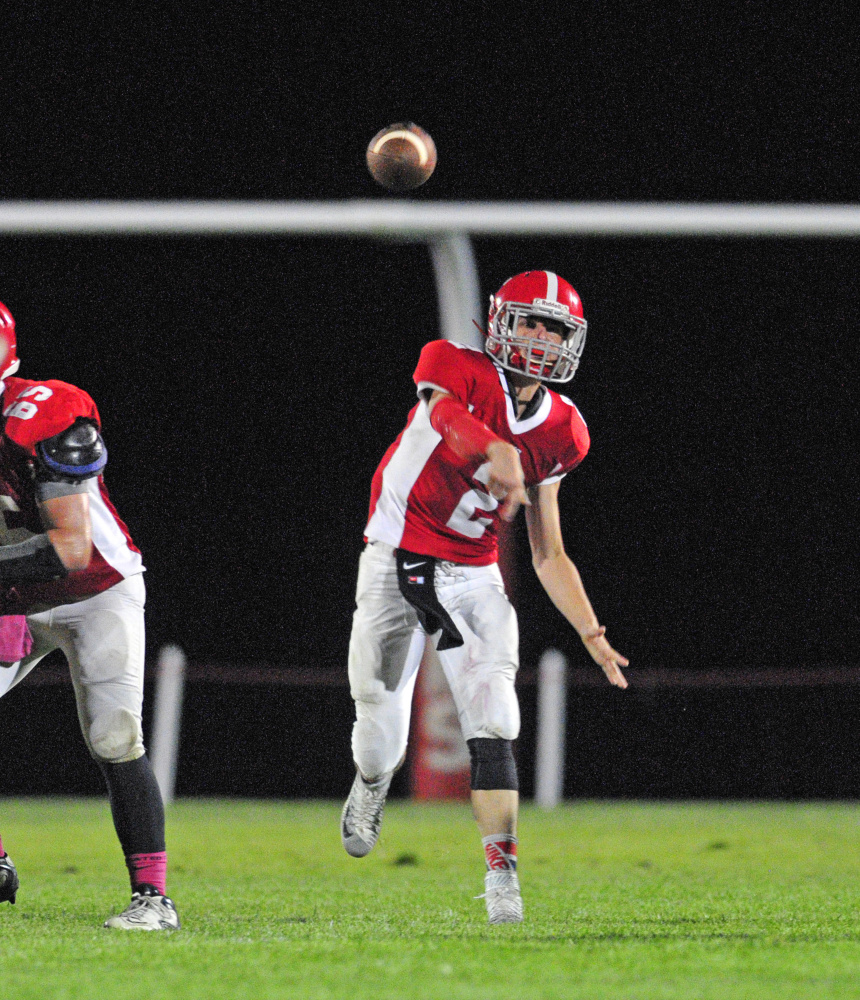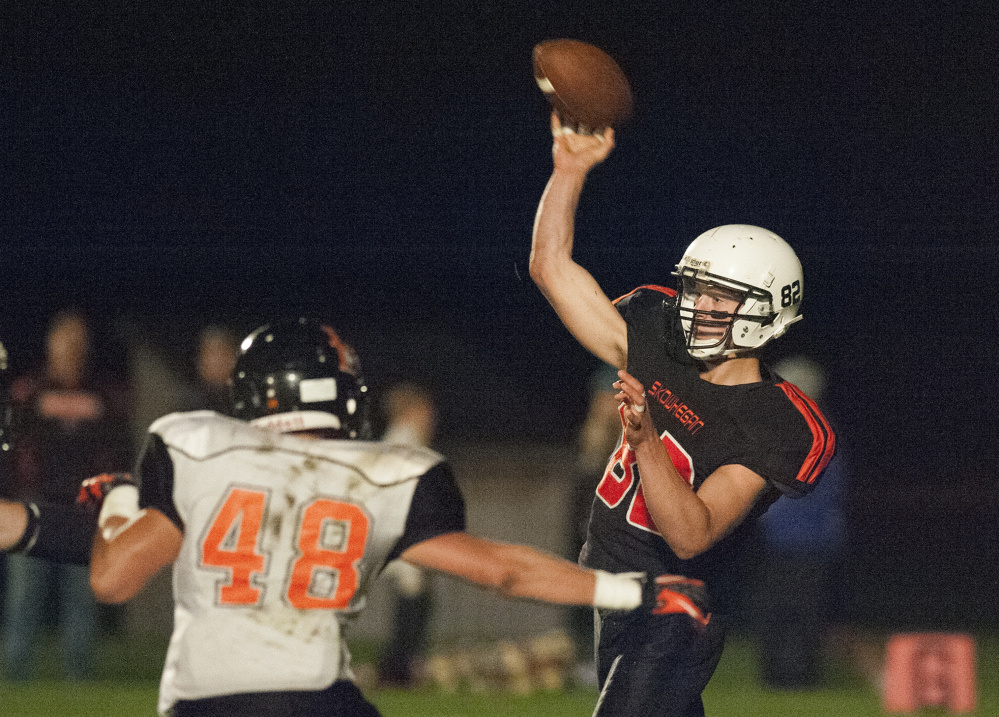Moving from one home to another rarely takes a single day or two.
That has been the case for former Mt. Blue High School football coach Gary Parlin. Two months ago he moved to Saco and is still finding little treasures stowed away in boxes, like the old book about the spread offense he stumbled upon Wednesday.
“One of my teachers that I had in grade school, who was the coach at Farmington High School at one time way back in the 50s, he brought me a book when we started running (the Cougar Gun),” Parlin said. “It was about I believe Texas Christian University and it’s from the 40s. If you look at this it has a lot of things that people are running in the spread today.”
As Parlin — who guided the Cougars to the Class B championship in 2012, his penultimate season at Mt. Blue — notes, the spread offense is hardly new. It has, however, enjoyed a great deal of exposure nationally over the past decade, thanks in large part to the high-scoring, successful spread attacks run at the collegiate ranks like that of the Chip Kelly-led University of Oregon teams.
Like with most sports, when successful trends emerge at the level above they tend to have a trickle down effect. Mt. Blue ran a version of the spread beginning in the early 1990s called the Cougar Gun, initially adopted as a version of the run and shoot before the Cougars began running it out of the shotgun. Currently two teams in Pine Tree Conference B — Cony and Skowhegan — run the spread.
According to first-year head coach and former offensive coordinator B.L. Lippert, the Rams started dabbling in the spread in 2009 and 2010 before going ahead with it full bore in 2011. Cony averaged 17.1 points per game and went 2-7 that season, but since then the results have spoke for themselves.
From 2012-14 the Rams lost no more than three contests in a season and averaged at least 30.9 points per game, including a run to the Class B championship in 2013 where they averaged 41.9 points per game. Through four games this fall Cony (2-2) is averaging 22.8 points per game and have only been held to single digits twice in the past four seasons. The Rams have not been shutout since the first game of the 2011 season.
“It forces teams to spread the field out and it puts defenders in space. One-on-one — in my opinion — the advantage goes to the offense,” Lippert said. “You’ve got space to move around and it’s hard to tackle in open space, whereas when you’re running maybe those run-heavy sets you have to create holes with the offensive line.
“A lot of teams are successful with it, we just weren’t finding a lot of success lining up in the I or Power I or anything of that nature, so we felt it was best to spread out and get our athletes in space.”
When the Rams decided to overhaul their offense Lippert said they studied what UCLA offensive coordinator Noel Mazzone was running when he held the same position at Arizona State.
“We sort of saw a lot of the stuff that he did that kind of matched up our formations, some of like our run game stuff and it paired with our screen game,” Lippert said. “It really clicked well.”
It was a similar genesis for Skowhegan’s attack under fourth-year coach Matt Friedman.
“When I started coaching at Jay (High School) we were a flexbone team and ran the triple option under center with two wings,” Friedman said.
Friedman said when they had a talented quarterback, Justin Wells, coming up through the system the team dropped back into the shotgun, sampling from what the offenses at Northwestern, Bowling Green and Air Force were doing at the time.
Friedman brought what became his version of the spread to Madison for his three seasons with the Bulldogs and later to Skowhegan, where the Indians have since incorporated the use of a tight end to accommodate the talent of players like D.J. Allen and Sam Baker.
Much like the case with Cony, Skowhegan has enjoyed a good amount of success out of the spread. In Friedman’s first three season the Indians averaged 26.0, 31.3 and 23.3 points per game, respectively. This fall they are 4-0 and averaging 28.0 points per game.
“Being in the fourth year of it now I don’t think they could go back to what they did before very easily,” Friedman said. “We’re starting to develop athletes to fill the positions that we need and they’re developing the skills to be spread athletes all the time.”
A common misconception about the spread is that it is a pass-only offense, but both the Rams and Indians have shown a good amount of balance thus far. Skowhegan quarterback Garrett McSweeney has completed 52-of-92 passes for 752 yards, 11 touchdowns and two interceptions this season. The Indians have actually attempted more rushes than passes, though, accumulating 530 yards and three touchdowns on 116 carries.
Cony (2-2), meanwhile, has looked to find more balance in its offense as of late. Quarterback Taylor Heath has completed 79-of-134 passes for 1,072 yards, 10 touchdowns and four interceptions, while the Rams — who were without running back Reid Shostak for the first six quarters of the season on offense — have carried the ball 86 times for 368 yards and four touchdowns.
“That’s the cat-and-mouse game that coaches play,” Lippert said. “If you’re going to load the box, we’ll throw it. If you’re going spread it out, then we’re going to try to run it. It makes it fun.”
It certainly has not been enjoyable for opposing defenses, particularly those that prefer to play more zone than man.
“If you’re outnumbered with really good, talented players on the offensive side you almost have to play some man-to-man,” Gardiner coach Joe White said. “But any time you man up on somebody that’s a better athlete you’ve got you’re work cut out for you.”
It is not likely that spread offenses become the norm in the PTC B and plenty of other sets have proven effective in recent years. Brunswick won at least seven games and averaged at least 32 points per game in each of the previous three seasons, and the Dragons are already off to a 4-0 start averaging 44.75 points per contest thus far this fall behind their run-heavy, under-center offense.
Personnel has played a big part in the success Cony and Skowhegan have enjoyed since switching to the spread offense, as good players lead to good results.
At the very least, though, each has proven that their decision to branch off into less-conventional offensive territory has become a viable means for maintaining success — so far.
Evan Crawley — 621-5640
ecrawley@mainetoday.com
Twitter: @Evan_Crawley
Send questions/comments to the editors.




Success. Please wait for the page to reload. If the page does not reload within 5 seconds, please refresh the page.
Enter your email and password to access comments.
Hi, to comment on stories you must . This profile is in addition to your subscription and website login.
Already have a commenting profile? .
Invalid username/password.
Please check your email to confirm and complete your registration.
Only subscribers are eligible to post comments. Please subscribe or login first for digital access. Here’s why.
Use the form below to reset your password. When you've submitted your account email, we will send an email with a reset code.